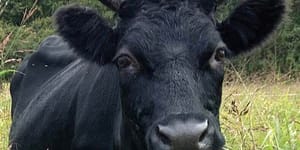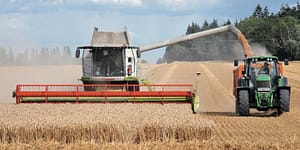Embracing Hope And Letting Go Of Fear

We can all get caught up in our own heads sometimes; fall down rabbit holes of fear and find ourselves stuck in situations we don’t want to be in. This can be especially true when it comes to climate change. Often, our resistance to change is a response to our fears of the future. But what can happen if we let go of that fear and let ourselves hope, if only for a moment?
The Reindeer Chronicles demonstrates how solutions to seemingly intractable problems can come from the unlikeliest of places, and how the restoration of local water, carbon, nutrient, and energy cycles can play a dramatic role in stabilizing the global climate. Ultimately, it reveals how much is in our hands if we can find a way to work together and follow nature’s lead.
The following is an excerpt from The Reindeer Chronicles by Judith D. Schwartz and has been adapted for the web.
In the middle of listening to a panel discussion on promoting regenerative agriculture worldwide, I decided to take a break. I wandered toward the exit and noticed Jeff Goebel and his wife, Myrna, sitting in the back of the room. I had heard about Jeff from Peter Donovan of the Soil Carbon Coalition. He knew Jeff well and was keen on his consensus work.
Peter told me about the consensus model, calling it the only approach he knew that produced lasting personal change.
Also, that it involves many hours or days of talking in a circle, conscious listening, and building trust.
“That sounds interesting,” I’d said to Peter in a noncommittal way, thoroughly dismissing the idea. I was too impatient for that sort of thing. Besides, at that point, I believed that achieving meaningful change was simply a matter of getting information out. By late 2017 I was no longer so sure.
Kneeling down and careful to speak quietly, I inquired about the Community Consensus Institute. By way of explanation Jeff told a story about work he did in the late 1990s in Mali, in the same general region along the Inner Niger Delta that John Liu visited in 2010. The community was in crisis. Eighty-five percent of the residents faced food insecurity, and the seven ethnic groups that lived or passed through seasonally were at war with one another. Particularly violent were land conflicts between farmers and pastoralists. For this USAID-funded Sustainable Agriculture and Natural Resource Management (SANREM) project, Jeff was hired to hold a series of workshops that included members of various tribes.

With that settled, he said to them: “Given that increasing 50 percent is impossible, if it were possible what would you do?” People came up with several ideas: They would diversify crops, plant leguminous trees, implement grazing strategies that build fertility, and so on.
They saw that there was actually a lot they could do.
Fifteen months later Jeff returned to Mali. “I was in the vehicle driving up to the meeting site,” he said, “and people were lined up along the road waiting for me. They could hardly wait to show me— they had increased food production 78 percent!”
This was quite a story. “How was this possible?” I asked.
“It was their set of beliefs that convinced them it was impossible. Once we acknowledged it couldn’t happen, it took the pressure off. This freed up their minds so they could consider what they would do. Hey—do you have time right after lunch? We can do a brief version of the workshop.”
I set out to find more partakers and brought in Renald Flores, a former investment banker from France who specializes in soil restoration and holistic decision making. He wears dreadlocks, perhaps to put distance between his current life and the years he spent in a suit. I’d met Renald at Caux, where he gave presentations on culture and decision making, including in the corporate world. “I am going to be very honest about the banking culture,” he’d said, and then proceeded to paint a sordid picture of the nihilism, greed, and competitiveness that festers beneath the bright, confident handshakes and silken neckties. I was ready to plead with him: No more honesty, please!
The four of us reconvened in a quiet corner near the main building and went around the group responding to a series of questions, switching the speaking order each time. The first query was, “How do you perceive humanity’s relationship to the natural world, and how do you feel about it?” Surprise: None of us was especially happy about the current state. The next was, “What is your greatest fear connected with this situation?”
Fear? I had been doing everything possible to fend off any scary thought related to the environment, warding away threats to the inner barrier protecting me from a grief I imagined would be unbearable. Fear was a hard, lacquered knot buried deep in my psyche. I trusted that as long as I didn’t trouble it, this nub of fear would remain inert. This is one reason I held tight to my focus on solutions. I wanted to reassure myself of the potential for environmental regeneration: opportunities to ally with nature that will be available to us when we as a society are ready to adopt them. How could I possibly articulate my fear, given the lengths I’d gone to convince myself it didn’t exist?
Still, consensus is about trust. And so, cautiously, each of us went to this dark place: acknowledging fear that the world would become uninhabitable, that humanity could go extinct, that our children’s children would subsist in a lifeless world of concrete. This was painful to say and to hear, even as we knew our words could only hint at the depth of the dread we harbored: apprehension of an existential nature, usually unspoken and therefore untouched.
At least in this moment, however, none of us was bearing it alone.
Fortunately, we didn’t leave it there. The following question was, “What would be the best possible outcome?” This is something we rarely consider, perhaps because managing fear absorbs so much of our energy. We shared what we wished for: For climate change to provide an opportunity for people to come together. For nations to stop spending money on war and instead devote money to healing the planet. For people to appreciate that we are part of nature. For 50 percent of global agriculture to become regenerative within three years.

That simple phrase “if it were possible” proved a potent invitation, and we launched into high-gear brainstorming. At one point, Renald said, “I would knock on the door of conventional farming companies, and I would say: ‘Let’s work together. We’ve seen how your way works, now try ours. Give us three years. If you don’t like the results, you can go back to what you were doing.’ I would go straight to Monsanto’s offices and say this.” (Gasp! Monsanto?) “We all need each other,” Renald continued. “Let’s give others the chance to be part of it.”
I don’t recall the other ideas, but I remember how it felt: breaking through the trepidation barrier—putting words to what had been locked away, isolating us—generated a sense of release. And a sense of energy, previously sapped by the dread that lurked beneath our actions and assumptions.
Recommended Reads
Recent Articles
Oxeye daisies are one of the most important plants for pollinators including beetles, ants, and moths that use oxeye daisies as a source of pollen and nectar. Instead of thinking about removing a plant like oxeye daisy, consider how you can improve the fertility and diversity of habitat resources in your home landscape, garden, or…
Read MoreIn her book, The Art of Science and Grazing, nationally known grazing consultant Sarah Flack identifies the key principles and practices necessary for farmers to design, and manage, successful grazing systems. This book is an essential guide for ruminant farmers who want to crate grazing systems that meet the needs of their livestock, pasture plants,…
Read MoreThis long-lived perennial legume is used for forage and erosion control. Kudzu is edible with many medicinal uses and other applications. Pollinators of all kinds love its prodigious lavender blooms!
Read MoreMove aside, maple! We have two new syrups to add to the table. Read on for insights on tapping, selling, and eating syrup from walnut & birch trees.
Read MoreWhy is modern wheat making us sick? That’s the question posed by author Eli Rogosa in Restoring Heritage Grains. Wheat is the most widely grown crop on our planet, yet industrial breeders have transformed this ancient staff of life into a commodity of yield and profit—witness the increase in gluten intolerance and ‘wheat belly’. Modern…
Read More








